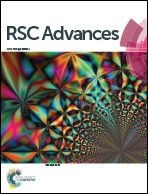Tunable superoleophobicity via harnessing the surface chemistry of UV responsive titania coatings†
Abstract
Superoleophobic surfaces exhibiting tunable wettability are prepared by the combination of simple spray coating of Ultra Violet (UV) responsive titania nanoparticles and a low surface energy coating of a self-assembled monolayer (SAM) of 1H,1H,2H,2H-perflurodecyltrichlorosilane (PFDTS). Spray coating creates random micron-sized roughness with reentrant geometry, a necessary requirement for the superoleophobic surface, and a porous network at the nanometer size level, confirmed by the field emission scanning electron microscope (FE-SEM) images. By employing the rough surface and a low surface energy monolayer, the substrates possess superhydrophobicity with a water (γ = 72 mN m−1) contact angle of 163° and superoleophobicity with a decane (γ = 23 mN m−1) contact angle of 144°. Wettability of these surfaces is completely reversed to the superoleophilic state upon 6 h of UV irradiation. A quantitative X-ray photoelectron spectroscopy (XPS) analysis has confirmed the mechanism of decomposition of PFDTS molecules on the superoleophilic surfaces via interaction with the defect Ti3+ states of titania upon UV exposure. Furthermore, the superoleophobicity is restored to complete the transition cycle by changing the surface chemistry of the UV exposed surface via annealing and regrafting of the PFDTS monolayer.



 Please wait while we load your content...
Please wait while we load your content...